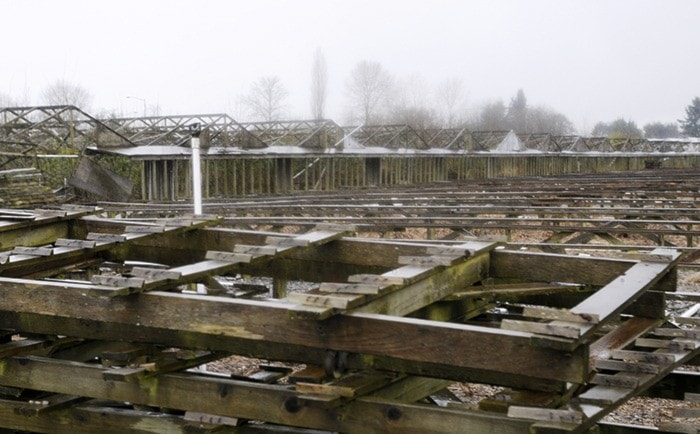Maple Ridge council is keeping the Pelton tree nursery property as one option for growing its industrial base.
The land on the northeast corner of 203rd Street and Golden Ears Way – more than 250 acres, all in the Agricultural Land Reserve – is one of eight areas eyed for commercial/industrial use as the district tries to broaden its tax base.
A staff report on the Pelton property says its “prime location” on the road leading to the Golden Ears Bridge should be considered a “long-term venture,” if the seven other areas have been ruled out.
Much of that Pelton land was sought for exclusion from the Agricultural Land Reserve in 2010, but the was application was rejected. Proximity to the bridge was said to be no justification for removing farmland.
The staff report says pursuing the Pelton property for industrial use is a “risk-filled strategy” that would require Metro Vancouver approval to change its regional plan, which sets out urban boundaries for each municipality.
“I’m fine with leaving it as part of the discussion, but I think we have to be really careful,” Mayor Ernie Daykin said at council’s Monday workshop.
All of council voted to consider the land for ALR removal.
“It may have some potential, but I think we need to exhaust every other option that we have … and not be reliant this will happen.”
Coun. Cheryl Ashlie wanted the Pelton area to be limited to agricultural or industrial uses, saying the area is highly regarded as farmland and that the public only would support agricultural-type uses.
However, the rest of council didn’t want to limit any possible use.
“This probably is the prime-est location closet to markets and transportation corridors. For those reasons, it needs to stay in the plan,” said Coun. Michael Morden. “I’m not in favour of specifying what this might look like.”
Coun. Al Hogarth also wanted the land to be part on the list of future industrial areas, noting the provincial review of the Agricultural Land Reserve by the provincial government could lead to another exclusion application.
Councillors didn’t like the label “industrial,” though, when considering future areas, because of connotations of smoke stacks and heavy industry.
“As soon as you use the term industrial, it brings up a whole bunch of thought processes for people,” said Hogarth.
However, that’s the term used by Metro Vancouver in its long-term plan, which identifies areas for such use. Industrial now more often means business park, light industry or commercial areas, council heard.
And changing the term could make it confusing for the public about what actually is being considered, said Ashlie.
“We know what industrial is. We just have to make sure we tell the public what it is.”
Council has already told staff to look at four other areas as possible locations for business parks or light industry.
Those areas:
• 28 acres of Ministry of Transportation and Infrastructure property on Lougheed Highway, just west of Kanaka Way;
• 60 acres at 128th Avenue and 232nd Street;
• 13 acres on Lougheed Highway, near Kwantlen First Nations reserve;
• Thornhill urban reserve, balancing industrial with residential use as development occurs.
Monday, council approved checking out other areas for light industrial use: 84 acres on Albion flats, east of 105th Avenue; developing a small commercial area on 248th Street and Dewdney Trunk Road; and, 84 acres in the Albion industrial area, south of Lougheed Highway.
Hogarth, a realtor, also wanted to create an area plan to create more dense subdivisions in the 248th Street and Dewdney Trunk Road area, where acreages now predominate.
“I actually think we can take an area that’s full of urban sprawl, or the epitome of urban sprawl. I think we can turn it into a model neighbourhood with more than just 20,000 sq. feet [commercial].
“It isn’t functioning as a true neighbourhood.”
But Ashlie said council already rejected expanding its urban area and allowing development there.
“We can’t change that today,” said the mayor.
Council disagreed with a staff suggestion that an incentive plan be developed to encourage growth in the Albion industrial area.
Staff also suggested that property owners be consulted before a concept is created for the area. However, Bell said the plan should be created first then presented to the owners. Staff have already met property owners.
“I feel that we as council should be setting the direction,” Bell said.
“I don’t know at what point we decided to give so much control to the property owners down there.”
But public works general manager Frank Quinn said property owners have to support the plan otherwise it’s “doomed for failure.”
Hogarth though suggested industry could move out of Albion flats and locate on Kwantlen First Nations reserve land farther east on Lougheed Highway.
Staff will come back with an overall strategy but not before council again discusses the options.
According to Metro Vancouver, Maple Ridge is project to double its number of jobs from 23,000 in 2006 to 48,000 in 2041.
“We don’t want to get caught up in paralysis by analysis,” said Daykin after council spent three hours discussing places for future businesses and jobs.
